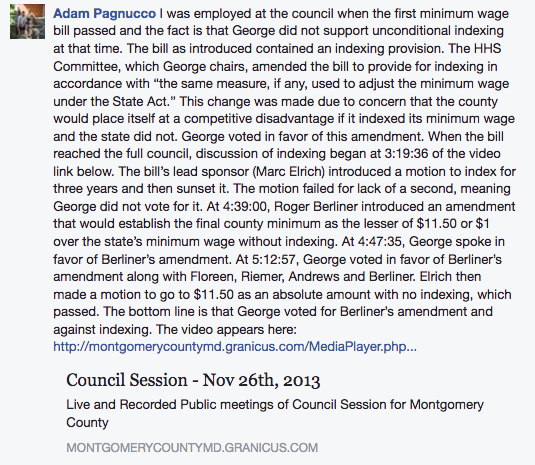George Leventhal and David Trone, two prospective candidates for county executive in 2018, made comments seemingly designed to make news–and they did in Bethesda Beat–as they debated the issue of pay-to-play politics. Leventhal charged that Trone’s contributions amount to pay-for-pay politics while Trone called Leventhal “a fool, F-O-O-L, and a bully.”
Trone’s Contradictory Statements
Leventhal’s attack centered on Trone’s political contributions:
“[T]he Trone brothers made enormous political contributions in order to get access to the Wisconsin market for their product,” Leventhal said. “They’re indicative of just one trend in the industry of paying off politicians to get what they want. The Trones have done that over a long period of time.”
Indeed, during his congressional campaign, Trone admitted bluntly “I sign my checks to buy access.” Now, he’s trying to walk it back:
Trone said he and his brother make donations to elected officials whom they believe have an interest in furthering “the common good” and who support economic initiatives that benefit the consumer.
Not Leventhal’s Best Issue Either
Leventhal attacks Trone for making supposedly corrupting donations to buy access. However, Leventhal has accepted hundreds of thousands of dollars of campaign contributions from business:
Leventhal says that he has never allowed any contributor to “buy access” but is well known for his support of development interests. While he contends otherwise, Leventhal’s situation is no different from that of any other person who accepted money from the Trone brothers.
Now, George Leventhal sidesteps this past showering in funds from business and touts his participation in the public campaign finance system as evidence of new purity:
“That’s precisely why I’m so delighted to participate in the public finance system,” Leventhal said. “That option wasn’t available to me previously, but I believe it will take the influence of big money out of politics.”
Except that not all of his colleagues took as much “big money” in the past as Leventhal. Marc Elrich, another rival for county executive, received very little from business. The 32% share of Elrich’s contributions from individual donations under $150 was also twice as high as the 16% of Leventhal’s contributions.
Leventhal’s Lurch Left
Following the debate on raising the minimum wage, this is now the second issue in a very short period on which George Leventhal has hugged Marc Elrich tightly. Abandoning his past business ties, Leventhal touts a $15/hour minimum wage with the fervor of a convert, and regularly plugs his embrace of public financing.
The strategy of imprinting himself in the media as the true progressive tribune is not a bad one. In recent weeks, his combination of abrasive outspokenness has gained him more media attention than his rivals. As Trump showed in the Republican primary, that can work wonders.
On the other hand, Leventhal has a long record. Will his new embrace of a much higher minimum wage and attacks on major campaign contributions gain him progressive support? Or will it just leave primary voters wondering why they should vote for mini-Marc when Marc is also on the ballot?












